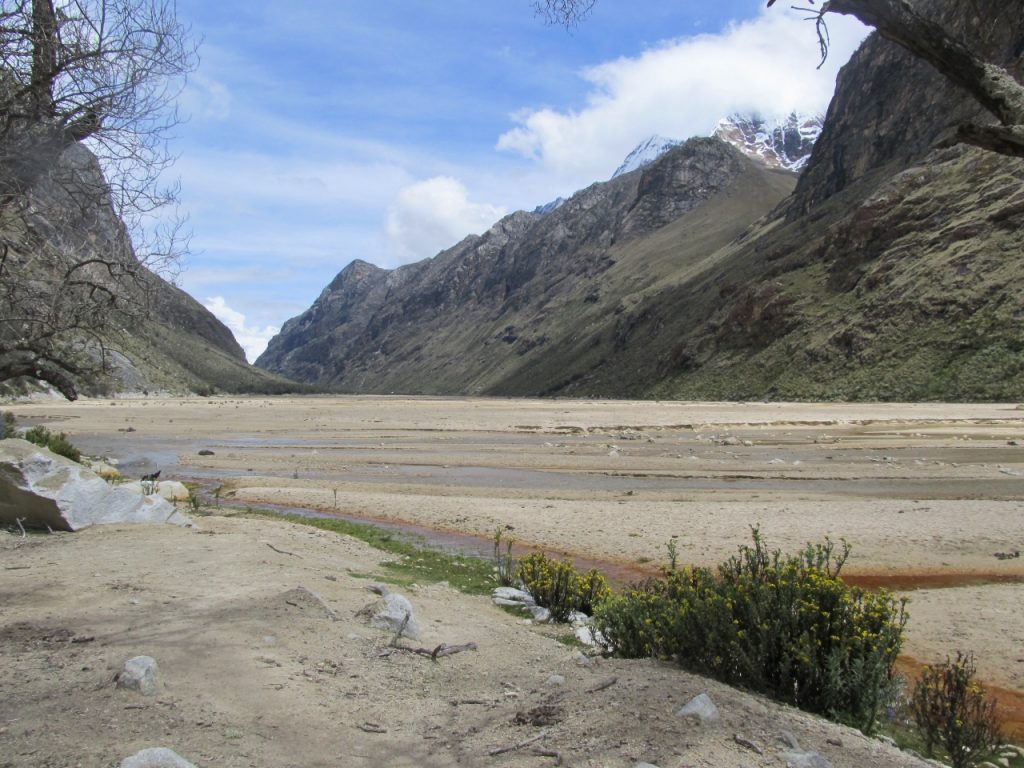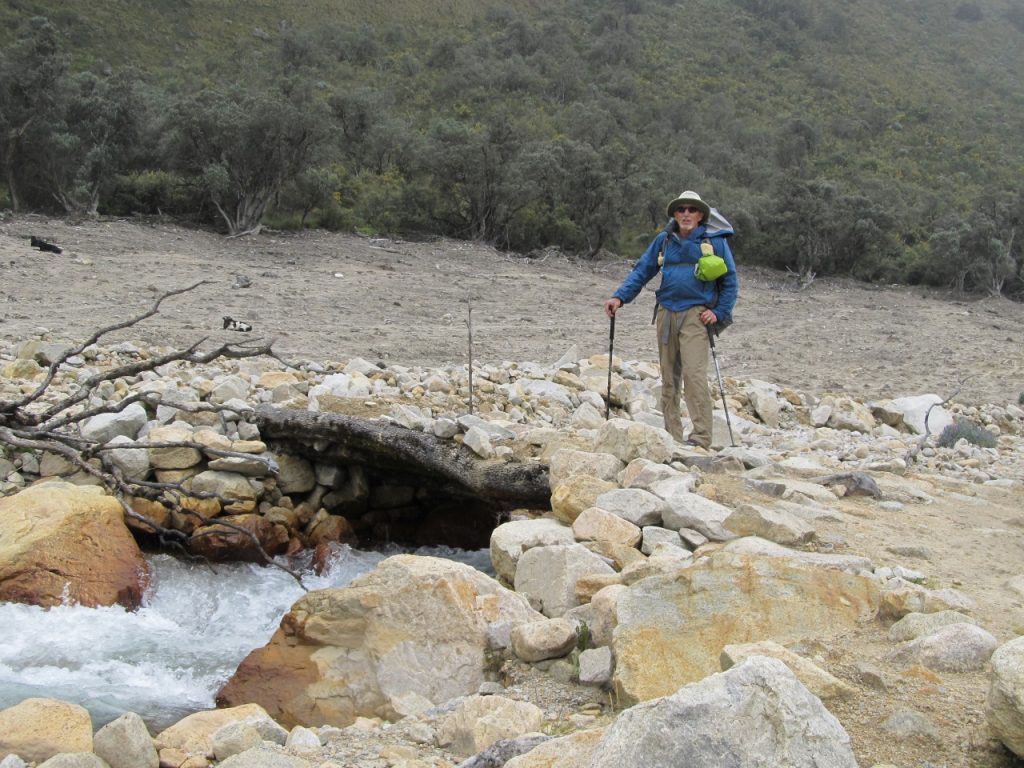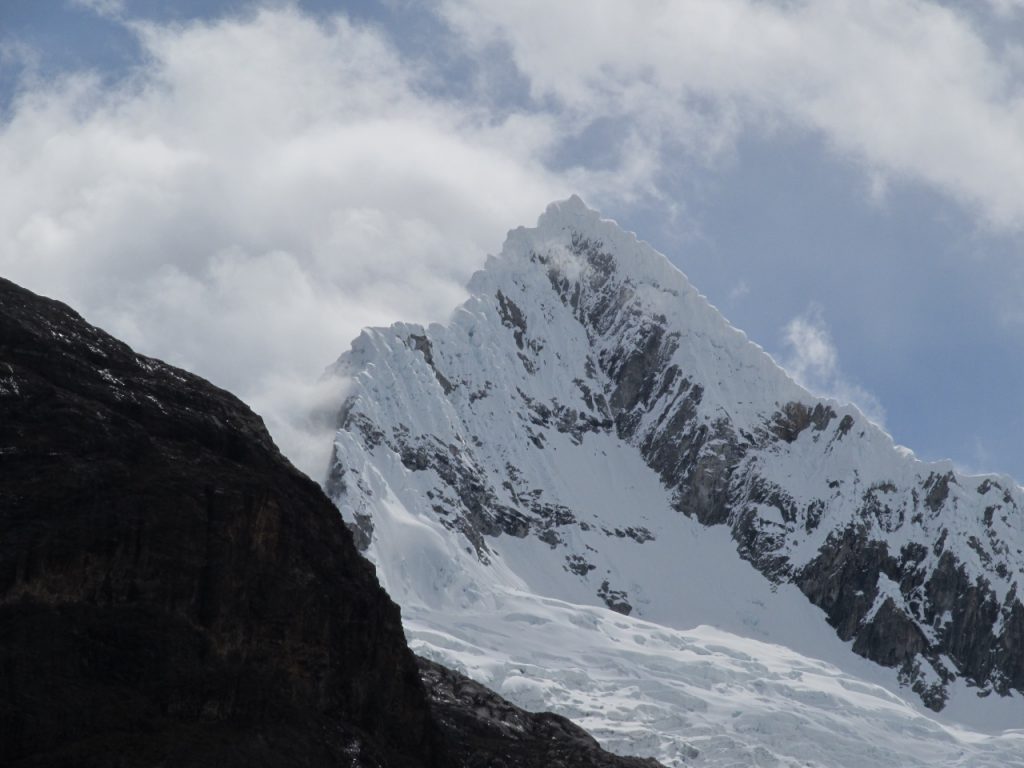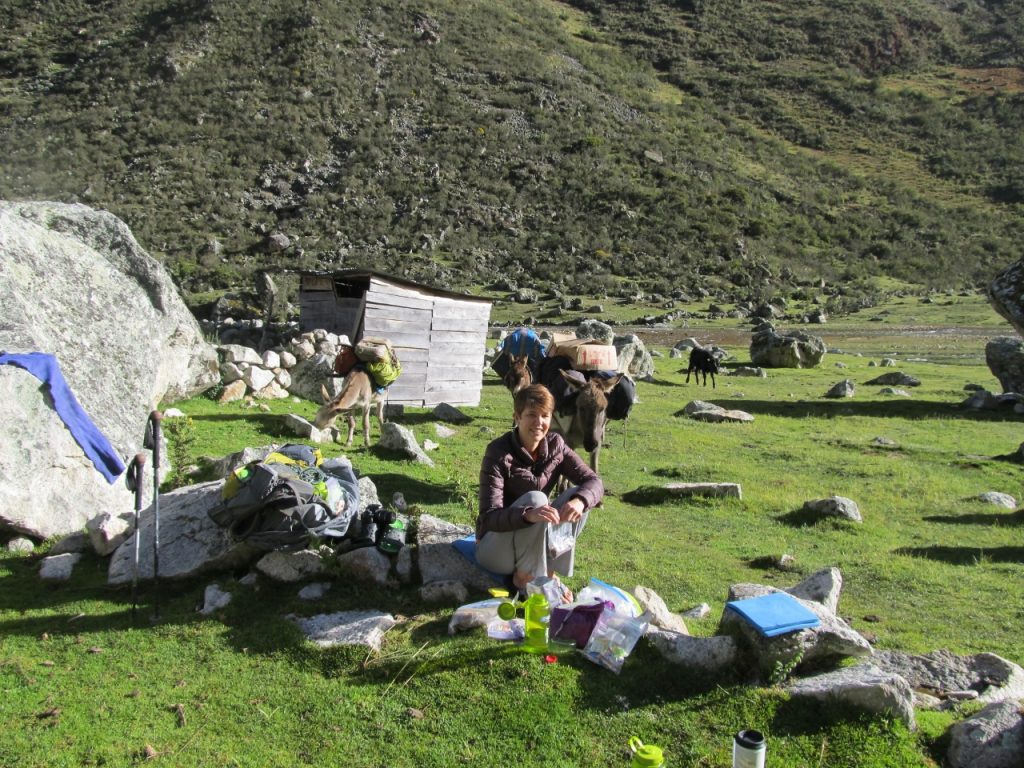We had completed our first day of backpacking the Santa Cruz Trail in the Cordillera Blanca, a mountain range in Peru, and were ready to tackle the second day. My husband and I were hiking independently but had camped in a designated campsite near a guided group. To see how we planned for our independent trek, see the articles listed at the end of this article.
We woke to the sounds of snuffling and found a calf munching contentedly on the grass just outside of our tent. When I stumbled out I felt like we were late, even though we had no schedule but our own. The hikers in the group that was camping near us already had their day packs on and were preparing to leave. It was a gloriously sunny morning but quite chilly, probably in the upper 30s. I put on my heavy fleece-lined wool hat and kept my pants on instead of switching to shorts. I dug around for my gloves and slipped my lightweight down jacket on, hoping it would be enough. I was toasty, soon had the hat and gloves off and even pranced around in my flip flops getting water at the river. As a I contemplated the herd of cows milling around and thought about the mules we had seen along the way I realized that, as clear as the water looked, rushing down from the glaciers up high, that this was probably some of the dirtiest water we had ever encountered backpacking in terms of bacterial contamination. I told Steve we’d better be vigilant about purifying our water.
The hikers in the group departed but their porters were still bustling around breaking camp. Soon, however, the mules were loaded and on their way. We waved at the muleteer and he gave us a big smile that flashed some golden teeth as he called out, “Vamanos amigos!” while pointing at the trail. “Si, si, uno momento,” I replied. “I think he thinks we’re late,” I said to Steve with a laugh. “We’d better get going.” This was the first time we had backpacked in another country outside of North America and, while I didn’t sense any particular danger, I thought it would be nice to stick close to the group.
The hiking was easy and the trail was mostly flat as we walked through field after field of thickets of blue lupine. The river had carved out a wider space here compared to the day before. The water had space to spread out and the trail wound through fields of wildflowers and brush. We enjoyed plentiful blue sky but I spotted puffy white clouds in the distance so I knew it wouldn’t last. Stopping often to take pictures of distant waterfalls, one after the other, gave us an opportunity to admire each one with their own shape and personality. Some were delicate frothy affairs, others were thin, silvery ribbons while a few sported thick, burly spurts of water gushing from the rock. We stopped so often that we started to worry that we would never make camp by nightfall so we tried to be more selective. Eventually we got jaded and said, “Oh, another waterfall. Ho hum.” We spotted the tops of glaciers in the distance, teasing us with long ribs of frosted snow. Wispy clouds gathered over the glaciers so we only got tantalizing glimpses that drew us forward. The sun behind us was appealing but we had to head further into the wild to see what those glaciers were all about.
Lunchtime found us at a small lake surrounded with many different types of colorful wildflowers. The bread wasn’t holding up very well but luckily the rehydrated bean mix was tolerable to eat with a spoon, supplemented with bites of bread and cheese. The trail was narrow beside the shore so we were barely off the trail, but it was a pleasant enough respite.

The flattened remains of Lake Ichiccocha
After lunch we departed from the lake and entered another world. Gone were the lush tropical plants, narrow trail and babbling brook. Flat as a pancake, a sea of sand looked as if it had been freshly bulldozed in preparation for a subdivision. The river seemed to disappear but it was just hidden in a narrow course on the far size of the field. Small sticks and stones were scattered evenly over the area. This vast expanse of nothingness was all that was left of the mighty Lake Ichiccocha that provided the once-iconic image that almost always represented the beauty of the trail in travel journals and trail guides. One day it was there, just had it had been for untold decades, the next it was gone, wiped out by an avalanche of snow, mud and rock that rumbled down from the heavens in 2012 in a landslide. We were prepared for this, having read recent trip reports, but it still took us awhile to put two and two together. We tentatively stepped onto the sand, finding it firm, and wondered where the river had gone. The sand was compressed enough that it was not difficult to walk on and instead of following a prescribed trail we could wander wherever we wanted. We started seeing rivulets of water on our side of the sandy plain, braided ribbons of water going every which way. Eventually a distinct trail resumed and all was well until it simply dropped off into the river. “Hmmm. What now?” I said. We had a snack and debated the merits of a river crossing versus an overland trek, each of us lobbying for our favored approach. Steve was concerned about the cold water while I didn’t relish bushwacking over the steep escarpment that hung over the river. After Steve scouted the overland route we went that way, pulling ourselves over large boulders, trying to dodge the prickly plants that tried to eat us. Safely on the other side we proceeded along the right side of the canyon, as we had been since starting the trek in Cashapampa but now the trail angled to left. We walked across the sand, following rock cairns, and tried not to lose the path.

The hidden bridge
It was easy to see a long way across the flat expanse and I could see no evidence of a bridge that the guidebook mentioned. We weren’t certain where we could once again start relying on the guidebook since we were still in the part of the landscape that had been so severely rearranged. We went all around, backtracked to make sure we hadn’t missed anything, scouted above and below where we thought the trail was and still were stumped. Finally I spotted a slight variation in the color scheme of the sand and rock. We had been expecting a big structure but instead it was very small footbridge made from a few logs that spanned the river. The logs were covered with rock so it was not obvious from afar. On the other side we passed a junction where a trail led to a high alpine lake, Lake Arhuaycocha, popular side trip that we were too late in the day to pursue, so we turned right and headed toward camp. Hint: If you find yourself going up some steep switchbacks after crossing the bridge, you’re heading to Lake Arhuaycoha. Look for stone cairns along the edge of the forest that lead to the trail on a more gentle gradient on the right.
The clouds were piling in now, dropping the temperature precipitously. Since the trail climbed steeply I stayed warm but as we reached the top of the incline a cold drizzle started. We stopped to arrange my poncho on my pack and I donned my rain jacket. “I hope we find the camp soon,” I said, concerned that we had frittered away so much of the day taking photos of waterfalls and trying to find a way around the missing section of trail. We hurried along in light drizzle, my hands getting colder by the minute. We scanned the horizon, which was becoming more mountainous again after our long day traveling along mostly flat terrain. Finally, we spotted the circular shape of the stone outhouse that heralded the camp, and soon we noticed the colorful array of tents of our group from the night before. “Yay, we found them,” I said, as the rain fell steadily. The ground was soft and squishy, more like a bog, and I very much looked forward to our dry tent. Thankfully, the trail led directly to an obvious bridge and the “Taullipampa” sign welcomed us to the official camp at 13,943 feet (4250 meters). Whew, we were pretty high. No wonder that last incline had me breathing hard. I was excited that I had felt so good up to that point and had not felt the effects of altitude. The Diamox (acetazalamide) was working. No one from the other group was visible as they were all tucked securely into their tents, staying dry.

One of many glaciers that teased us through the clouds
We scouted around for a tent site but the ground was quite boggy on the perimeter of the camp and we didn’t want to be right on top of the group. The trail looked like it ascended steeply beyond the camp so options were limited. I started shivering and Steve could see that I needed to get warm fast. We ended up pitching our tent right next to the latrine. It wasn’t a site I’d describe as ideal but it had some important benefits going for it. It was flat, close to a side stream, wasn’t too boggy and had extremely good access to the bathroom facilities. An hour after we got set up the rain subsided leaving a thick mantle of gray clouds clinging to the mountain tops. They were high enough that our surroundings were revealed. A huge hanging glacier hung in the sky, only visible through a narrow cleft in the rock wall towering above us. Our tent sat in the perfect vantage point to see this wondrous sight, our front door pointing right at the glacier. We were able to hang our wet clothes on rocks and low bushes long enough for the gentle breeze to dry them out. I’m always a bit anxious before crux day and tomorrow we would top out going over Punta Union Pass at 15,600 feet. I tried to calm my nerves but looked forward to an early start and hoped for the usual pattern of sunny mornings to get us over the pass.
See Day 3 for the continuation of the hike.
See related articles:
Hiking the Santa Cruz Trail in Peru: Day 1
Hiking the Santa Cruz Trail in Peru: Day 2
Hiking the Santa Cruz Trail in Peru: Day 3
Hiking the Santa Cruz Trail in Peru: Day 4
Planning an independent backpacking trip on the Santa Cruz Trail, Peru: Part 1
Planning an independent backpacking trip on the Santa Cruz Trail, Peru: Part 2
Day 2 stats:
Route: Llamacorral camp to Taullipampa
Starting elevation: 12,139 feet (3,700 meters)
Ending elevation: 13,943 feet (4250 meters)
Mileage: 8 miles
Hiking time: 7 hours from camp to camp (including breaks)
Overall impression: A moderately easy day made somewhat challenging by searching for landmarks and losing the trail on the flat sandy expanse of the previous lake bed.
Trip Stats:
Route: Cashapampa to Vaquieros
Starting elevation: Cashapampa 8,202 feet (2900 meters)
Highest point: Punta Union Pass 15,584 feet (4,750 meters)
Ending elevation: Ending elevation: Vaqueria 12,139 feet (3,700 meters)
Total mileage: 31 miles (50 km)
Itinerary: 4 days, 3 nights
Recommended guidebook:

Inga enjoys a sunny breakfast among the livestock
 Previous Post
Previous Post

Phil says:
Hi! What month did you complete the trek?
Inga says:
The third week of April.